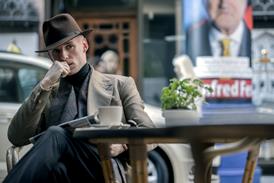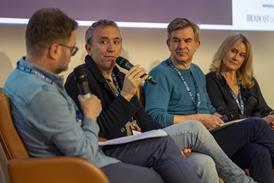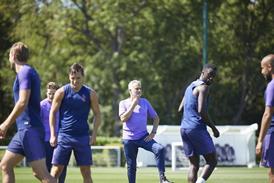Whether you believe, like anthropologist Desmond Morris, that Big Brother is still “the most interesting social experiment ever conducted on TV” or think it is well past its sell-by date, reality TV is undeniably a technical feat.
The show, and others like it, generate huge amounts of material and require a fast turnaround, both of which demand on-location editing. This means an entire post-production unit will reside on-site for the duration of the show.
Other reality programmes supported by on-location editing include Big Brother: Celebrity Hijack, I'm a Celebrity... Get Me out of Here!, Hell's Kitchen and The Match. They all need production and post-production teams that can capture 24 hours of footage a day and create a compelling narrative, as well as accessible archive facilities - requiring large numbers of staff and vast amounts of kit, as well as a lot of technical knowhow. Big Brother has 24 editors and 12 support staff on the post side, while I'm a Celebrity employs around 400 people for any one show.
This service has been the forte of some of the UK's most innovative post houses, such as Resolution and The Farm. So it was a shock when Resolution, the post house that pioneered on-location editing in 2000 with the first Big Brother - and also completed location-based projects on Fame Academy and Pop Stars - went into administration last month, citing falling rates and high overheads.
Format shift
Resolution's demise can be attributed to both a drop in rates and rise in overheads, although some say that it may have been partly to do with the reduction in demand for on-location editing - around a third of its programming was in this genre.
There is currently a move away from on-location editing on live daily shows - programmes such as The Match and Fame Academy have not been recommissioned - towards shows that go live to air on a weekly basis and feature pre-recorded inserts such as The X Factor, Strictly Come Dancing and Make Me a Supermodel. This is a less post-intensive style of show that requires the management of a great deal of footage (a small crew will be filming contestants continually) but does not require on-site editing facilities.
The Farm - the other major UK-based post house to have developed location-based editing in 2003, for Endemol's The Salon - is now less focused on location editing than on shows such as The X Factor and Britain's Got Talent which are posted off-site and have longer lead times.
According to one industry source: “Producers have found ways of making reality TV that is less complex and less costly. Cameras, crew, post staff and accommodation all make location-based shows massively expensive. With falling rates, producers are looking to make cost savings.”
How it works
So what does on-location editing involve and, given the high costs and market conditions in post, is there a future for companies specialising in this area?
Big Brother is fairly typical of on-location editing and is filmed (at Elstree Studios) using 50 cameras in the house and garden. Logging is one of the key elements of on-location editing and once the footage is fed into a control room, a team of loggers with specially adapted keyboards record each scene using hot keys for the contestant's name and key themes. The logging software will have been developed by the post house for the show in question.
Once content is logged, edit producers will look at the log list for storyline developments, with a director deciding how much to focus on each. They will then pass an edit decision list (EDL) through to a team of editors. When the content has been cut, scriptwriters will determine the key themes and messages to be communicated to viewers by the hosts or voiceover.
Graham McGuinness, director at Root 6, which helped Uncle develop logging software for Endemol's The Salon, says: “Shows such as Big Brother run on rails now - the infrastructure and software are mature and established”.
When it comes to editing, on-location shows demand a great deal of equipment, with kit required for both Big Brother and I'm a Celebrity having grown over the years. The shows currently use 16 and 23 Avid Adrenalines respectively, with Big Brother also using some Final Cut Pros.
Storage is also a huge concern for on-location editors. The first Big Brother in 2000 was captured on just 27 cameras but generated a phenomenal 32km of footage a day. All of this had to be sorted by the loggers. Significantly more footage has been shot in the recent series because more of the content is going online requiring more storage. Of the 1,180 hours of footage shot a week, eight hour-long programmes are made with 12 live shows.
The birth of reality TV roughly coincided with the release of Avid's first Unity storage system. Unity, which holds large volumes of media for access by multiple work stations, was one of the first storage area networks to be marketed to the post industry.
Both I'm a Celebrity and Big Brother switched to an Avid Isis from Avid Unity storage last year. The Big Brother Isis offers 32TB of storage, which means it can hold up to 200 hours of standard definition footage.
Both shows also trialled the disk-based Sony XDCAM in their last series. “The consensus seems to be this is the way most programming is going,” says I'm a Celebrity executive producer Richard Cowles. “We ran a tape and tapeless solution alongside each other and had a few issues initially with the volume of content. The issues we faced were ensuring that the bandwidth was available at all times to all systems. We resolved them by increasing the speed of the connections between servers.”
Rising from the ashes
Despite an uncertain outlook for on-location editing on live daily shows, one company that has faith in the genre is DDF. Set up by seven former Resolution staff, it is capitalising on developments in workflow technology to create a new, streamlined company. With the help of tapeless technologist EVS, Avid and ERA, DDF has developed a tapeless system which will simplify productions of live reality shows such as Big Brother: Celebrity Hijack, which it is currently working on.
DDF technical director Mark Openshaw says: “This new solution incorporates bespoke software to manage and interface hardware from Avid (Transfer Managers, Interplay and Isis) and EVS (XT(2), IP Director).”
The system doesn't require digitising - the process by which the editor waits for footage from the tape to be loaded into an edit system. Instead it feeds straight into the Isis. Once a decision is made by the story director or story producers the editors can act straight away without any digitising. Directors can make more choices more quickly and can move from one storyline immediately if the second is more interesting. In addition, experienced editors can begin the editing process before they are given directions, where they have a feel for the story.
It also means that DDF can deal with increased footage without the additional edit suites that would normally be required. The system is being developed to allow for rapid multi-purposing as it can automatically send content direct to 3G or the web. Openshaw says: “The faster you get the footage to the end user, the more engaging it is.”
This will potentially remove some of the more repetitive and complex tasks for the people working on it. Similarly those employed in the creation of spin-offs such as Big Brother's Little Brother or X Factor will have more time to polish the shows they are working on. Openshaw said: “Producers are always keen to have more time for staff to work on the shows.”
The future
So, will this new streamlined workflow help DDF avoid the problems experienced by Resolution and build a successful business based on on-location editing?
The consensus within the post industry was that while Resolution was a respected company that offered a unique, efficient service in a post market suffering from oversupply and falling rates, it was likely to suffer when shows it worked on such as Fame Academy and Popstars were not recommissioned.
Envy senior producer Jannine Martin who worked on The Restaurant advises companies working in this genre: “Reality TV shows are a good source of income but they require a very high level of service provision over a long period - this may be a drain on a firm's resources. It is important for facilities to balance this type of work against drama, docs and short-form work.”
Although on-location editing is the focus for its business, DDF is aware of the need to diversify beyond the genre. Managing director Mike Saunders says: “We will continue to work on Celebrity Hijack but we are keen to broaden our portfolio in this area. We are looking to secure outside broadcast work such as sports, festivals and other outdoor events.”
It should have no problems finding a use for its skills, though, as Root 6's McGuinness points out: “Staff with experience on reality TV tend to be extremely efficient media managers and this is one of the most desirable and transferable skills in the industry.”
Case study
I'm a celebrity... get me out of here!
Set in the Australian jungle and hosted by that effervescent duo Ant and Dec, I'm a Celebrity... Get Me out of Here! has rekindled the ailing careers of many C-list celebs, including Peter Andre, Katie Price, Jason Donovan and Christopher Biggins.
The show faces all the traditional on-location challenges with the additional difficulties of being set in the jungle. The 23 Avid Adrenaline edit suites are set in Portakabins in a jungle clearing. They are air-conditioned and powered by super-silent generators with back-ups.
The workflow resembles that of Big Brother, with 40 cameras on camp and two streams, comprising one main stream and a second consisting of three ISO cameras (which are used for cutaway shots to back up the main stream/story).
The logging software CMS is a bespoke system created by Australia-based Cutting Edge, the post house also responsible for Hell's Kitchen and the Australian Big Brother.
When pushed for an opinion on the future of reality TV, executive producer Richard Cowles says: “I'm a Celebrity is an entertainment show and the building blocks, such as the Bushtucker trial and the Celebrity Chest, are typical of this type of show. While it is still entertaining viewers, it has got life.”
Although average ratings for series seven were down slightly on the previous year (on average 30% compared with 34% of the share), it still ranks as one of the most watched shows in ITV's schedule.





























No comments yet